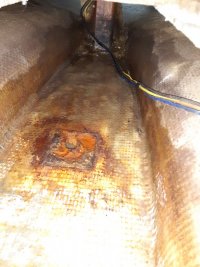petrouchka23
New Member
After my boat co-owner confirmed submerged rock locations, in areas known to have rocks, I decided to do the repair work myself. Boat is up on the hard and I've been grinding away, and have a few questions with what I've found.
1. Grinding down through the keel damage, I eventually hit a hollow space. No material fell out, so I think it must have always been like this. The material you can see through the hole is like a solidified epoxy resin: it looks translucent, it sounds solid, and it feels very hard. Is that just a different type of boat-building material? I'm planning to taper out the work area to achieve a more gradual taper, but feel that I'm in over my head if I start to get into the keel core. Any thoughts on my approach?
2. This square thing in the bilge, say 2 feet aft of the mast, does anyone know what it's for? It looks to be pretty much centered over the keel. Was it part of the building process? For those who don't know, some of the E23s (and mine) had encapsulated keels, and those who posted before maintain there are no keel bolts. If this isn't a keel bolt, then what could it be?
3. How do I update my boat info in my handle (nametag thing)?
1. Grinding down through the keel damage, I eventually hit a hollow space. No material fell out, so I think it must have always been like this. The material you can see through the hole is like a solidified epoxy resin: it looks translucent, it sounds solid, and it feels very hard. Is that just a different type of boat-building material? I'm planning to taper out the work area to achieve a more gradual taper, but feel that I'm in over my head if I start to get into the keel core. Any thoughts on my approach?
2. This square thing in the bilge, say 2 feet aft of the mast, does anyone know what it's for? It looks to be pretty much centered over the keel. Was it part of the building process? For those who don't know, some of the E23s (and mine) had encapsulated keels, and those who posted before maintain there are no keel bolts. If this isn't a keel bolt, then what could it be?
3. How do I update my boat info in my handle (nametag thing)?


